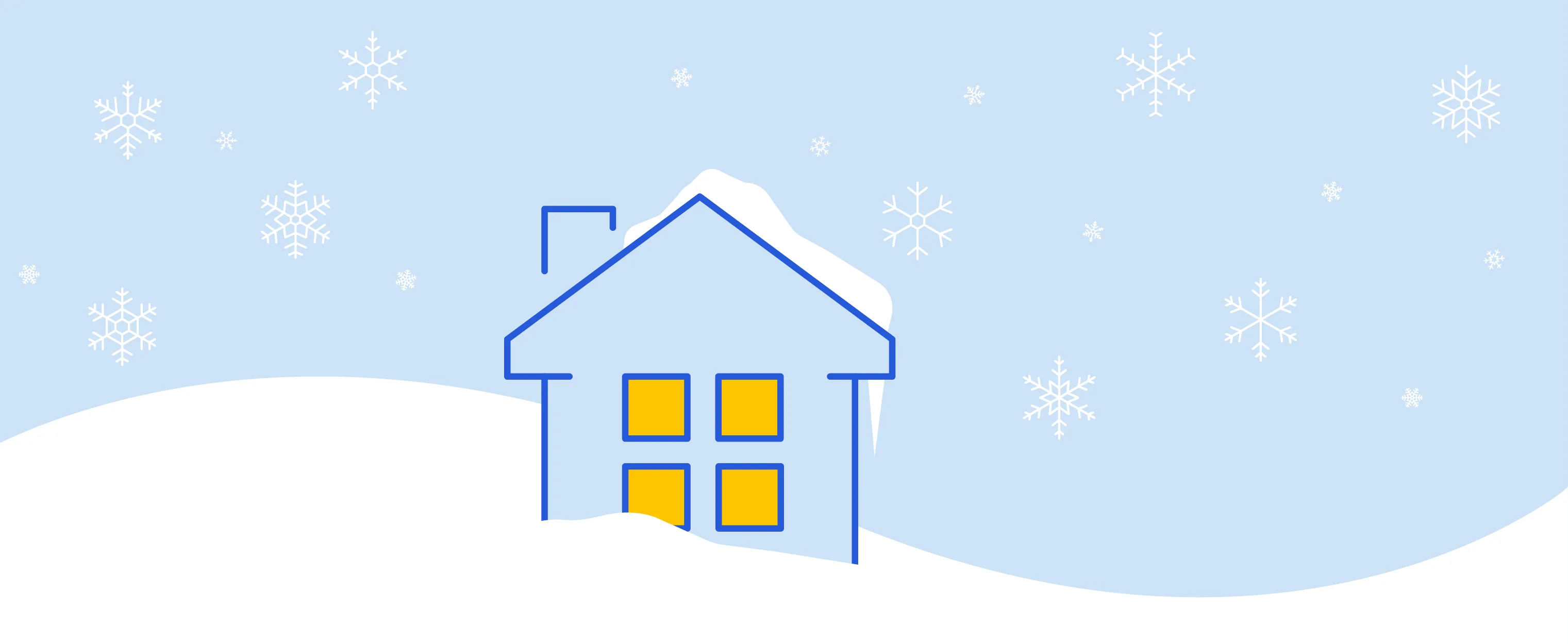How to Winterize Your House

Summary
From servicing your HVAC system to insulating windows, small efforts to winterize your home now could help you save all season long. Get started with our home winterization checklist.
In this article:
If you’re a first-time homeowner, or if you’ve recently moved to a chillier climate, you might be wondering how to prepare your house for winter. Even areas that are historically warmer during the winter months, like Texas, are prone to cold weather hazards.
From sealing drafty windows to buying a new snow shovel, taking some time to prepare now can save you time, money and headaches throughout the winter. When it comes to preparing for winter, the sooner, the better. Leaving things as is could add up to significant charges on your heating bill, or worse, costly repairs that force you to dip into your emergency fund.
Winter supplies could be scarce if you wait — after all, Jack Frost isn't known to wait for an invitation! Check out our home winterization checklist to learn the best cold weather tips for your home, so you can prevent expensive heating bills and repairs.

11-Step home winterization checklist
Preparing for winter can seem a little overwhelming, but these winter home tips will help you make your home safe, warm and winter-ready:
1. Install door sweeps
Do you feel a constant draft under an exterior door? Does the floor near the door feel cold, too? If your doors are letting too much cool air in, it could increase heat and energy costs.
There’s a simple solution: a door sweep. A door sweep is a flexible piece of rubber, foam or plastic that can be attached to the base of a door with adhesive or screws. You could even buy one that slides under your door. Either way, you’ll have a barrier between the frigid winter air and your warm, cozy home. Best of all, door sweeps are typically affordable, so they won’t break the bank.
2. Service your furnace or boiler
Just like the engine in your car, your house needs a tune-up from time to time. As you’re preparing your home for winter, make sure to get your furnace or boiler inspected. Making any needed repairs may help prolong your furnace’s operating life and could also identify potential gas and carbon monoxide leaks.
You could clean and inspect your furnace yourself, but for safety reasons, it may be best to call a certified technician for a professional evaluation and service. If you catch an issue early, it could save you money compared to total replacement costs because of an undetected problem.
3.Use plastic film to insulate windows and prevent drafts
A small window draft can add up to a big expense on your heating bill. To prevent drafts and keep costs low, insulate your windows with plastic film. Plastic window film is available at most home improvement stores and is affordable and easy to install. If you live in an especially cold area, try adding a layer of bubble wrap to the film for extra protection.
4. Inspect the roof
Annual roof inspections can help you find small issues to repair before they become big and expensive problems. Climbing onto the roof can be dangerous, so if you don’t feel comfortable performing the inspection yourself, you may want to hire a professional. Some roof inspectors offer a flat rate for standard inspections, but the rate can fluctuate due to the size, slope and type of roof. As you’re getting ready for winter, be sure to inspect these three major areas:
1. Shingles: Check for curling, buckling, tearing or missing shingles
2. Gutters: Ensure gutters are secure and clear ofdebris
3. Flashing: Confirm that flashing is not rusted, dentedor damaged
5. Replace worn weatherstripping
If you notice cold air seeping in around windows and doors, even after installing plastic film and door sweeps, chances are your weatherstripping is worn and needs to be replaced.
Weatherstripping is the material used to seal gaps around windows and entryways. When it becomes old or damaged, warm air can escape and cold winds can blow in.
The U. S. Department of Energy (DOE) offers winter home tips on weatherstripping to help you choose and install the best kind for your home.1
6. Trim your trees
Those winter winds can be strong — one gust of wind in stormy, icy weather could cause fallen branches and trees, putting your home at risk of serious structural damage. So, trim back any branches hanging over your home and make sure there are no dead or dying trees nearby.
Trimming trees can be hazardous, so you may want to consider hiring a professional.
7. Protect your pipes
If a pipe in your house becomes frozen and bursts, it can be a rather messy (and costly) problem. You’ll need to repair the damage as quickly as possible, which could leave you scrambling to find emergency funds.
When you winterize your home, you could reduce the chance of a burst pipe by:
- Draining the water from your outdoor spigots
- Closing the interior shut-off valve
- Applying heat tape or other pipe insulation methods to any pipes that are near exterior walls or prone to freezing
8. Reverse ceiling fans
Did you know that most ceiling fans spin two ways — clockwise and counterclockwise? Check the base of your fan and you should find a switch. When you’re preparing for winter, simply flip this switch and ensure the direction of airflow is clockwise.
Because hot air rises, clockwise blades produce an updraft and push heated air down from the ceiling. Flipping the switch is a simple change, but it can make everyday living more comfortable and potentially let you set your thermostat lower, which could lead to savings on your heating bill.
9. Stock up on equipment
You never know when the first storm of the season can strike. So, it’s important to stock up on any equipment or supplies you may need to weather the next big storm. If you use machinery, such as a snowblower or generator, get the engines tuned and keep gallons of gas on hand and stored in a safe place.
The sooner you can gather your home's winterization essentials the better; prices typically rise when demand increases right before a big snowstorm. Basic winter equipment to stock up on when preparing for winter should include:
- Snow shovel
- Ice pick
- Salt or ice melt
- Salt spreader
10. Check drainage around your home
Just like leaky pipes, poor drainage or leaks around the exterior of your home could lead to expensive flooding damage, especially as heavy snow begins to melt. Before winter, take a lap around your house and look at the soil around the foundation of your home and rain gutters. Make sure there aren’t any places that could potentially allow water to seep into your home.
11. Get an energy audit
The last step on our winterizing your home checklist is to have your home checked for possible issues that could impact your energy usage. Investing in an audit now could save you energy costs during the winter months if any problem occurs.
You could follow the DOE’s tips to conduct a do-it-yourself energy audit for free.2 However, if you’d like a more thorough expert review — and possibly get a tax break — a professional home energy audit may also be a cost-effective option.3
If you need extra money to cover expenses related to our home winterization checklist, a home improvement loan could help you stretch your budget to ensure you're well-prepared for winter.
Give winter a warm welcome
Whether you’re a snow lover or prefer to be a “snowbird,” you can face the cold with confidence. Enjoy a warm and cozy season knowing that your home is winter-ready.
Sources
- https://www.energy.gov/energysaver/weatherstripping
- https://www.energy.gov/energysaver/do-it-yourself-home-energy-assessments
- https://www.energy.gov/energysaver/professional-home-energy-assessments
This article has been updated from postings from 2019-2021. Matt Diehl, Melina Duffet, and Kim Gallagher contributed to this post. Infographic by Zac Willett.
This article is for general education and informational purposes, without any express or implied warranty of any kind, including warranties of accuracy, completeness, or fitness for any purpose and is not intended to be and does not constitute financial, legal, tax, or any other advice. Parties (other than sponsored partners of OneMain Financial (OMF)) referenced in the article are not sponsors of, do not endorse, and are not otherwise affiliated with OMF.



